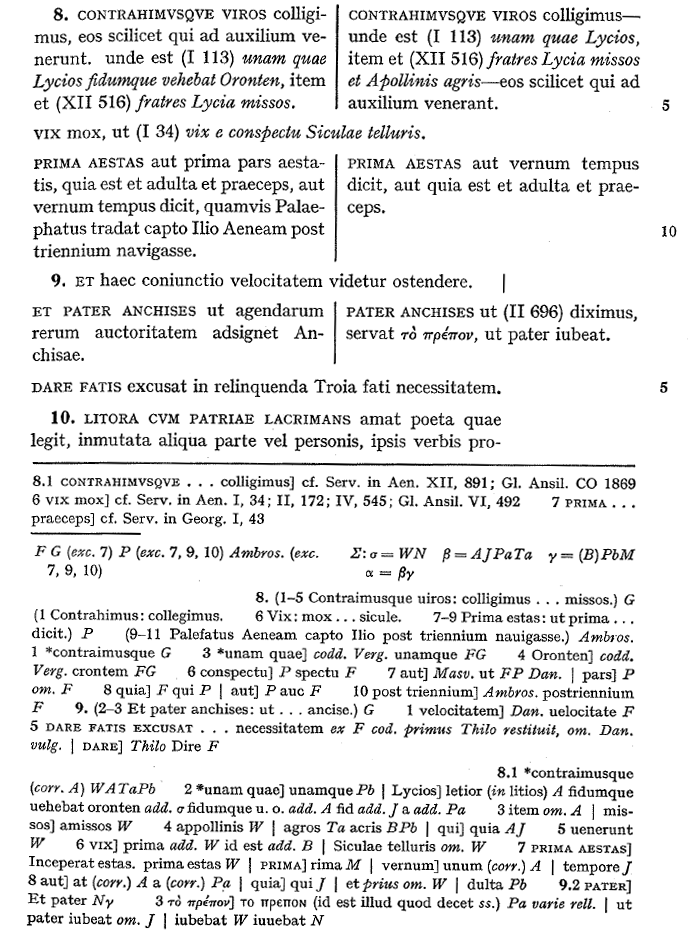The paper linked below is the text of what should have been the paper I delivered at the 2018 AIA/SCS annual meeting. Unfortunately, the conference’s start date coincided with the arrival of the “bomb cyclone” nicknamed Grayson in Boston, which curtailed pretty much all travel up the Eastern seaboard of the United States. It sounds like it was a fantastic meeting, and I was very sorry to miss it.
The paper was written for delivery to an audience of Classicists who know little about TEI, but I think it will be accessible to anyone with a bit of background. So an introduction is in order. The panel was titled “New Age Servius”. Who was Servius, and why should you care? Maurus Servius Honoratus was a 4th/5th century grammarian, an ancient scholar, who wrote a commentary on the works of Vergil. So he’s interesting as an example of ancient scholarship, and also because his commentary preserves lots of knowledge about Roman religion, history, culture and language, as well as quotes from otherwise lost works. The commentary is also interesting because we have it in two distinct versions, the shorter version of Servius and a longer version which compiles Servius’s entries with others, many from another commentary, which may be the one by Aelius Donatus, otherwise lost. The medieval compiler has done more than just mash these texts together: stylistic alterations have been made to make the new text flow better, and some of Servius’s entries have been trimmed. The longer version is known as Servius Auctus or Servius Danielis (Daniel’s Servius) from Pierre Daniel, who first published it in 1600. In the paper, I refer to the shorter version as “Servius” and the longer as “DS”. Since this was meant for oral delivery, I thought there would be less chance of confusing both myself and the audience by maintaining a strong aural distinction between the two.
The history of editions of Servius is a bit fraught. The only complete edition is Thilo’s (vol. 1 from Archive.org) from the 19th century. It combines the two texts into a single one, indicating with italics where text comes only from DS. Combining the texts in this way can’t help but do some violence to both, however. The series commonly known as the “Harvard Servius”, begun by E. K. Rand, who published volume 2 (Aeneid 1-2) in 1946, and continued by A. F. Stocker and A. T. Travis with volume 3 (Aeneid 3–5), 1965, attempted to represent both, but to format the texts in such a way that it was easy to tell what text belongs to DS and what to Servius. P. K. Marshall worked on volume 4 (Aeneid 6–8), and C. E. Murgia on volume 5 (Aeneid 9–12). Sadly, neither lived to see the work to its conclusion. Robert Kaster collected Murgia’s papers and has completed work on assembling them into a publishable text. This is the work my paper refers to. James Brusuelas, who was also to present on the canceled panel, is working with Marshall’s text of the commentary to Aeneid 6.
The Harvard Servius presents the text full-width on the page where Servius and DS agree, prints DS-only text 3/4-width and flush left, Servius-only text 3/4-width and indented 1/4, and where both have text but it doesn’t agree, it is printed in 2 columns, DS on the left and Servius on the right. So Servius is interesting from a technical perspective too. Figuring out the best way to mark it up is challenging and likewise figuring out how best to render it.

An example page from volume 3 of the Harvard Servius
To accompany the paper, I worked up some demos. The first shows a snippet of Murgia-Kaster’s Servius from the beginning of book 9, the second and third show how easy it is to produce either Servius-only or DS-only versions of the text. Only the CSS and a little bit of Javascript are different in the three views. All 3 are generated on the fly in your browser from a single XML source using CETEIcean plus some extra Javascript. None of this should be regarded as final. There are still features of Murgia-Kaster that I haven’t decided how to represent, and other aspects of the markup that have yet to be finalized. I’m still inserting critical apparatus entries into the source, so it’s not fully populated at the time of writing. I will be updating it.

